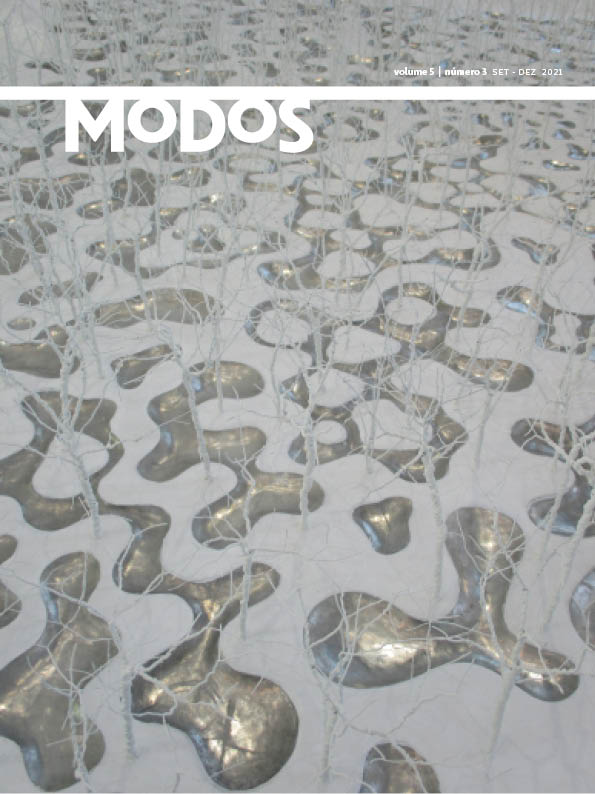Abstract
Animals have been displaced from the natural environment, appropriated like things in general and, when exhibited in legitimized institutions, confirmed as art objects. Although we note the regularity of these beings in artistic works, the theme lacks recognition. Changes in the approach of Art History, however, favor the debate around the issue by drawing attention to practices little or almost never studied, such as the use of the animal's body. Even so, artists did not give up using specimens of the most unusual species in their work, including those that feed on decomposing matter, classified as scavengers. This article intends to establish a parallel between these specimens which, despite enjoying a bad reputation, occupy a fundamental position in the cycle of life and contemporary artists who play a strategic role in maintaining the balance of the art ecosystem by employing animals of all origins in their productions.
References
BARBOSA, A. M. (Org.). Alex Flemming. São Paulo: Editora da Universidade de São Paulo: Imprensa Oficial do Estado, 2002.
BBC Brasil. MUSEU é multado por exibir "peixes no liquidificador", 25 nov. 2000. Disponível em: https://www.bbc.com/portuguese/noticias/2000/001125_peixe.shtml. Acesso em: dez. 2019.
BRADLEY, K. With Spiders and Space Dust, Tomás Saraceno Takes Off. In: The New York Times, p. AR-18, 21 out. 2018. Disponível em: https://www.nytimes.com/2018/10/19/arts/design/tomas-saraceno-palais-de-tokyo.html. Acesso em: jan. 2020.
BRAGA, Rodrigo. Rodrigo Braga. Disponível em: https://www.rodrigobraga.com.br/. Acesso em: fev. 2020.
DZIEWIOR, Y.; GOLDBERG, R.; STORR, R. Zhang Huan. London: Phaidon Press Ltd, 2009.
LAGNADO, L.; CASTRO, D. (Org). Laura Lima on_off. Rio de Janeiro: Cobogó, 2014.
MACIEL, M. E. Prólogo. In: MACIEL, Maria Esther (Org.). Pensar/escrever o animal: ensaios de zoopoética e biopolítica. Florianópolis: Editora UFSC, 2011.
MANN, Jon. When Joseph Beuys Locked Himself in a Room with a Live Coyote. In: Artsy. 3 nov. 2017. Disponível em: https://www.artsy.net/article/artsy-editorial-joseph-beuys-locked-room-live-coyote. Acesso em: maio 2019.
MATESCO, Viviane. Corpo, imagem e representação. Rio de Janeiro: Jorge Zahar Ed., 2009.
NAVA, Raquel. Raquel Nava. Disponível em: http://raquelnava.net. Acesso em: out. 2019.
PRATS, Fernando. Carnaza de la poesía. Santiago (Chile): Galeria Patricia Ready, 2016. Catálogo de exposição.
RAMOS, Nuno. Bandeira branca, amor: Em defesa da soberba e do arbítrio da arte. In: Folha de S. Paulo Ilustríssima. São Paulo, p. 4-5, 17 out. 2010.
RAUSCHENBERG, R. Robert Rauschenberg Foundation. Disponível em: https://www.rauschenbergfoundation.org. Acesso em: mar. 2019.
RENAULT, C. Tamm. Lembrar para esquecer: transitoriedade e criação. Dissertação de mestrado. Programa de Pós-Graduação em Artes da Escola de Belas Artes da Universidade Federal de Minas Gerais, 2008. Disponível em: http://hdl.handle.net/1843/JSSS-7WKG3Z. Acesso: fev. 2020.

This work is licensed under a Creative Commons Attribution-NonCommercial-ShareAlike 4.0 International License.
Copyright (c) 2021 Marco Túlio Lustosa de Alencar

